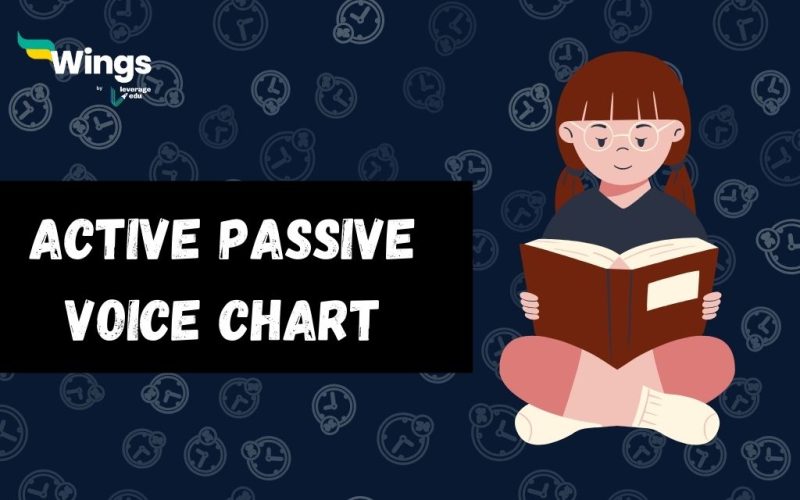Active Passive voice is a very integral part of English Vocabulary. Therefore one needs to be up to date with all the rules and know the usage. If you wish to know about Active Passive, then you have come to the right place. In this blog, we have listed an Active Passive Voice chart which will list all the rules behind constructing sentences.
This active passive voice chart will provide you with all the information on how you can use these rules.
This Blog Includes:
Also Read: Active and Passive Voice Rules for All Tenses [PDF Available]
What is Active Voice?
Active Voice is all about the subject performing an action. In English grammar, active voice is used to give information directly and clearly.
Example: The dog is chasing the ball.
What is Passive Voice?
Passive Voice is used where you need to emphasise the target of the action or the action itself rather than who or what is.
Example: The ball is being chased by the dog.
Here is the active passive voice chart with all the tenses which will help you understand how you can construct sentences by incorporating the rules.
Simple Present Active Passive Voice Chart
Here is a table which has listed down the rules of Active and Passive Voice with examples for Present Simple.
| Active Voice | Passive Voice (Auxiliary Verb – is/am/are) |
| Subject + V1+s/es+ object | Object+ is/am/are+ V3+ by + subject |
| Subject + Do/does+ not + V1 + Object | Object + is/am/are+ not + V3+ by Subject |
| Does+ Subject+ V1+Object+? | Is/am/are + Object+ V3+ by subject +? |
Here are some examples of both active and passive for Present Simple Tense:
Active: She reads a novel.
Passive: A novel is read by her.
Active: She does not paint.
Passive: Painting is not done by her.
Active: They grow crops.
Passive: Crops are grown by them.
Active: She teaches me.
Passive: I am taught by her.
Must Read: English for Competitive Exams [Grammar, Questions, Tips]
Present Continuous Active Passive Voice Chart
Here is a table along with examples for the Present Continuous Tense.
| Active Voice | Passive Voice |
| Subject + is/am/are+ v1+ ing + object | Object+ is/am/are+ being+ V3+ by + subject |
| Subject + is/am/are+ not+ v1+ ing+ object | Object + is/am/are+ not + being+V3+ by Subject |
| Object + is/am/are+ not + being+V3+ by Subject | Is/am/are + Object+ V3+ by subject +? |
Here are some examples of both active and passive for Present Continuous Tense:
Active: Radha is singing a song.
Passive: A song is being sung by Radha.
Active: Priya is not chopping onions.
Passive: Onions are not being chopped by Priya.
Active: The ministers are serving the poor people.
Passive: The poor people are being served by the ministers.
Active: She is disturbing Ramesh
Passive: Ramesh is being disturbed by her.
Present Perfect Active Passive Voice Chart
| Active Voice | Passive Voice (Auxiliary Verb- is/am/are + being) |
| Subject + has/have+ v3+ object | Object+ has/have+ been+ V3+ by + subject |
| Subject + has/have+ not+ v3+ object | Object + has/have+ not + been+V3+ by Subject |
| Has/have+ subject+ v3 + object+? | Has/Have + Object+ been+V3+ by subject +? |
Check out some examples of this tense in both active and passive voice:
Active: Manoj is singing a song.
Passive: A song is being sung by Manoj.
Active: Is Khushi buying a table?
Passive: Is a table being bought by Khushi?
Active: Rishi has created this masterpiece.
Passive: This masterpiece has been created by Rishi
Simple Past Active Passive Voice Chart
| Active Voice | Passive Voice |
| Subject + V2+ object | Object+ was/were V3+ by + subject |
| Subject +did+ not+v1+ object | Object + was/were+ not +V3+ by Subject |
| Did+ subject+V1+ object+? | Was/were + Object+ V3+ by subject +? |
Examples:
Active: Seema cleaned the floor.
Passive: The floor was cleaned by Seema.
Active: Aisha bought a car.
Passive: A car was bought by Aisha.
Active: I saved him from drowning.
Passive: He was saved from drowning by me.
Download Active Passive Voice Chart PDF for School
Here is a PDF of the active-passive voice chart which will help you with a better understanding.
FAQs
When constructing passive voice sentences, we often use this formula: form of “be” verb + past participle
In active voice sentences, we use this formula: Subject + past participle + object in simple past tense.
To change the sentence, interchange the object with the subject with each other, i.e. object of the active sentence becomes the subject of the passive sentence.
Related Posts
To advance your grammar knowledge and read more informative blogs, check out our Learn English page and don’t forget to follow Leverage Edu.
 One app for all your study abroad needs
One app for all your study abroad needs















 45,000+ students realised their study abroad dream with us. Take the first step today.
45,000+ students realised their study abroad dream with us. Take the first step today.
